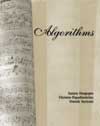
|  |
Book Preface| This book evolved over the past ten years froma set of lecture notes developed while
teaching the undergraduate Algorithms course at Berkeley and U.C. San Diego. Our
way of teaching this course evolved tremendously over these years in a number of
directions, partly to address our students’ background (undeveloped formal skills
outside of programming), and partly to reflect the maturing of the field in general,
as we have come to see it. The notes increasingly crystallized into a narrative, and
we progressively structured the course to emphasize the “story line” implicit in
the progression of the material. As a result, the topics were carefully selected and
clustered. No attempt was made to be encyclopedic, and this freed us to include
topics traditionally de-emphasized or omitted from most Algorithms books.
Playing on the strengths of our students (shared by most of today’s undergraduates
in Computer Science), instead of dwelling on formal proofs we distilled in each
case the crisp mathematical idea that makes the algorithm work. In other words,
we emphasized rigor over formalism. We found that our students were much more
receptive to mathematical rigor of this form. It is this progression of crisp ideas that
helps weave the story.
Once you think about Algorithms in this way, it makes sense to start at the historical
beginning of it all, where, in addition, the characters are familiar and the
contrasts dramatic: numbers, primality, and factoring. This is the subject of Part
I of the book, which also includes the RSA cryptosystem, and divide-and-conquer
algorithms for integer multiplication, sorting and median finding, as well as the fast
Fourier transform. There are three other parts: Part II, the most traditional section of
the book, concentrates on data structures and graphs; the contrast here is between
the intricate structure of the underlying problems and the short and crisp pieces of
pseudocode that solve them. Instructors wishing to teach a more traditional course
can simply start with Part II, which is self-contained (following the prologue), and
then cover Part I as required. In Parts I and II we introduced certain techniques (such
as greedy and divide-and-conquer) which work for special kinds of problems; Part
III deals with the “sledgehammers” of the trade, techniques that are powerful and
general: dynamic programming (a novel approach helps clarify this traditional stumbling
block for students) and linear programming (a clean and intuitive treatment of
the simplex algorithm, duality, and reductions to the basic problem). The final Part
IV is about ways of dealing with hard problems: NP-completeness, various heuristics,
as well as quantum algorithms, perhaps the most advanced and modern topic.
As it happens, we end the story exactly where we started it, with Shor’s quantum
algorithm for factoring.
The book includes three additional undercurrents, in the form of three series of separate
“boxes,” strengthening the narrative (and addressing variations in the needs
and interests of the students) while keeping the flow intact, pieces that provide
historical context; descriptions of how the explained algorithms are used in practice
(with emphasis on internet applications); and excursions for the mathematically
sophisticated. |
|
|